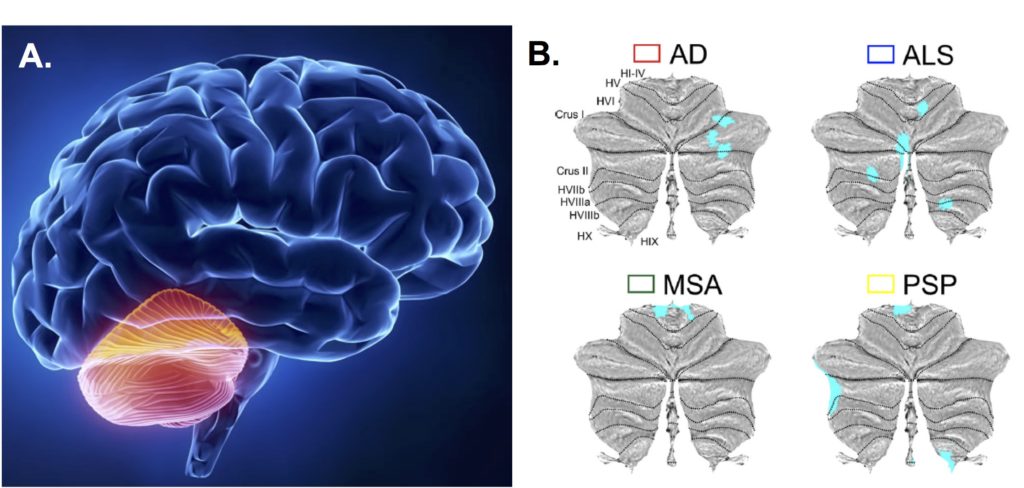In the current issue of JNNP, Gellersen and colleagues have published the first meta-analysis designed to assess patterns of cerebellar atrophy across different neurodegenerative diseases. Typically, neurodegenerative diseases have been linked to impairment in cortical and basal ganglia structures, however increasing evidence suggests that degeneration in the cerebellum also plays a role in these complex diseases. Even though the cerebellum has been well defined as a crucial brain area for motor control and coordination, its extremely extended connectivity into non-motor areas (such as prefrontal and parietal cortices) supports its role in cognitive and neuropsychiatric processes.
In this study, the authors studied the patterns of regional cerebellar grey matter (GM) loss in seven neurodegenerative conditions: (i) Alzheimer’s disease (AD), (ii) Parkinson’s disease (PD), (iii) Huntington’s disease (HD), (iv) frontotemporal dementia (FTD), (v) amyotrophic lateral sclerosis (ALS), (vi) multiple system atrophy (MSA), and (vii) progressive supranuclear palsy (PSP). They carried out a systematic search according to the Preferred Reporting Items for Systematic Reviews and Meta-Analyses (PRISMA) guidelines. After selecting 54 studies (a total number of n=1609 patients and n=1471 controls), the authors found consistent clusters of cerebellar atrophy in AD, ALS, FTD, MSA and PSP, but not in HD and PD. Importantly, the patterns of cerebellar GM atrophy were disease-specific (see figure 1), with some areas of overlap found in AD, ALS, FTD and PSP (Crus I/II), as well as between MSA and PSP (left lobules I–IV). Finally, GM atrophy co-located with cerebellar areas associated with motor (PSP, MSA) or cognitive dysfunction (FTD, ALS, PSP).

The results presented in this JNNP article revealed that neurodegenerative diseases have unique patterns of cerebellar atrophy. These findings suggest that cerebellar GM changes are disease-specific and correspond to cortical or subcortical changes specific to the underlying pathology. Furthermore, these patterns were also related to cognitive, sensorimotor and affective symptoms in the respective disorder. Although it is well recognized that the cerebellum modulates diverse neuronal networks to regulate motor, cognitive, behavioural, and limbic circuits, the origin of the patterns of cerebellar atrophy is unknown. Further studies should address if these changes are due to Wallerian degeneration secondary to cortical or subcortical degeneration, or if they are primarily cerebellar in origin. In the meantime, the GM cerebellum atrophy in neurodegeneration can provide valuable diagnostic and pathological insights and therefore contribute to the understanding of this group of challenging human diseases.
Well worth the read!!
Read more at http://jnnp.bmj.com/content/88/9/780